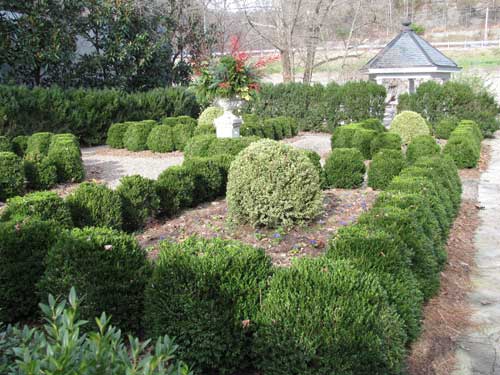Landscape
The Landscape at Craik-Patton

The Craik-Patton historical house is located in Daniel Boone Park along the Midland Trail, the path of the settlers and now one of the scenic drives in West Virginia. Plants, shrubbery, trees and special gardens enhance the Craik-Patton setting along the majestic Kanawha River. Over the years, many Charleston area garden clubs have contributed to the landscaping projects at Craik-Patton.
As one enters the gates of Craik-Patton, sunlight filters through a grove of River Birch and a white Fringetree growing on the front lawn. Beyond the Ruffner log cabin to the left of the property, a D.D. Blanchard Magnolia and a Snowball Viburnum contribute to the restful scene, even though traffic whizzes by on Rt. 60.
In 2002, Bill Mills of Terra Salis Landscaping of Malden, West Virginia, was invited to reinvent the garden. He created the Parterre Garden at the rear of the house to complement the classic Greek revival architecture of the house, temple-like and free of ornamentation.
French parterre gardens originated in the 15th century gardens of the French Renaissance influenced by the sculptured, formal gardens at Versailles, the summer palace of French royalty. The Kensington Palace gardens of England and other European estates were influenced by parterre design.
The Craik-Patton Parterre Garden consists of planting beds edged in tightly clipped hedging with paths as dividers that form a pleasing, symmetrical pattern. The focal point of the garden is a Caron Jardiniere set on a Washington Pedestal of dry tamped limestone. The green walls of the parterre are Justin Bwouwer Boxwood, a dwarf form of the species. This same boxwood has been used at parterres at the White House. Seasonal annuals such as Pansies, red and yellow Tulips and blue Salvia are featured within the garden beds.

A pair of mature Fastigiata Boxwood are the focal point of the herb garden.* A tall hedge of Southern Magnolia has been planted behind the garden that provides a lush evergreen backdrop. Four Nellie R. Stevens Holly are sheared into pyramids, adding a strong note of structure and formality. As one steps down the side path of the house, a Cornelian Cherry is planted close to the foundation of the house. A path takes visitors down to the river for a stunning view. American Dogwood and Flowering Quince are original plants that are growing around the Well House.
*Records from the Colonial Dames Archives indicate that the James Craik family created an herb garden at the original homesite on Virginia Street. In the 1830s, doctors relied on their herb gardens to treat patients. The Craik family grew herbs to handle ailments, cooked with herbs, and traded seeds with neighbors in order to have herbs in their home gardens.
